Many have asked that question but they don’t seem to get the right answers especially considered how the term ‘drag racing’ is used when reporting the news. In fact, the negativity that people have of drag racing has largely been promoted in the media. That’s why people view this spot as illegal. It is not, therefore, surprising that a majority of people continue to view the amazing and family-friendly sport of drag racing suspiciously. But do they know any better?
In simple terms, drag racing is a sport in which pre-prepared vehicles compete in a controlled environment that is a drag strip. Participants in these races are governed by certain rules to ensure they remain safe while at it.

However, street racing is undefined and ungoverned. It is not the same as drag racing and is illegal. It is for this reason that those who participate in drag racing have been trying to uphold the reputation of a hobby or profession they hold so dearly. To them, it is not fair when those who know less about the sport do everything to tarnish drag racing.
As the name goes street racing takes place on public roads with the risk of endangering other road users including motorists and pedestrians. That’s not so for drag racing which takes place in specialized race tracks away from the traffic on the streets. After all, the aim of the races is to avoid the catastrophic risks of street racing.
Professional drag racers are usually taken through safety instruction, track orientation, and a demo run. That’s before they get suited and belted in the meticulously-maintained cars for an amazing but safe experience.
They are governed by a set of general regulations covering the following:
- Cooling system, flash shields, exhaust, fuel systems, lower engine containment device, liquid overflow, oil system, throttle, supercharger and restraint device, and vent tubes.
- Axle-retention devices, anti-blow device, clutch, flywheel, driveline, rear end, flywheel shield & motor plate, and transmission.
- Brakes & suspension. Steering, brakes, shock absorbers, suspension, wheelie, and traction bar rod ends.
- Ballast, alignment, deflector plate, ground clearance, frames, magnaflux certificates, parachutes, mounting hardware, roll bar, pinion support, wheelbase, and roll cage.
- Upholstery, seats, driver compartment, and window net.
- Tires and wheels.
- Wings, airfoils, fenders, competition numbers, hood scoop, floor, firewall, windshield, windows, and windscreen.
- Electrical control. Delay boxes & devices, batteries, ignition, master cutoff, starters, switches & buttons, taillights, and shift light.
- Apparel, credentials, appearance, arm restraints, driver restraint systems, helmet, head protector, neck collar, head & neck restraint devices, protective clothing, seat belts, and occupants.
- Support group. Data recorders, computer, generators, fire extinguisher, jacks & jack stands, oversize trailers, lifting devices, push bars, pressurized bottles, traction control, telemetry devices, two-way radio communication, tow vehicle, cameras, and warm-ups. Why Drag Racing Is Awesome
Compared to its street counterpart, drag racing is more concerned with the safety of the racers more than anything else. That’s the reason why it is considered legal. Not much can be said about street racing when it comes to safety and so it remains illegal.
